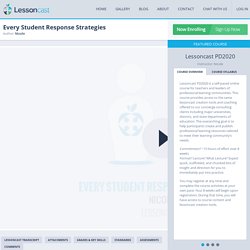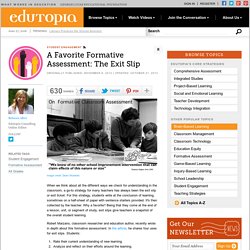

An ASCD Study Guide for Checking for Understanding: Formative Assessment Techniques for Your Classroom. This ASCD Study Guide is designed to enhance your understanding and application of the information contained in Checking for Understanding, an ASCD book written by Doug Fisher and Nancy Frey and published in September 2007.

You can use the study guide before or after you have read the book, or as you finish each chapter. The study questions provided are not meant to cover all aspects of the book, but, rather, to address specific ideas that might warrant further reflection. Most of the questions contained in this study guide are ones you can think about on your own, but you might consider pairing with a colleague or forming a study group with others who have read (or are reading) Checking for Understanding. Chapter 1: Why Check for Understanding? What are common ways that teachers check for understanding? Chapter 2. What is oral language? How Do We Know When Students Are Engaged? (Updated 11/2013) Educational author and former teacher, Dr.

Michael Schmoker shares in his book, Results Now, a study that found of 1,500 classrooms visited, 85 percent of them had engaged less than 50 percent of the students. In other words, only 15 percent of the classrooms had more than half of the class at least paying attention to the lesson. Every Student Response Strategies. True implementation of personalized learning in schools requires a shift in the roles of educators and a shift in educator professional learning.

This course examines the evolving role of teachers incorporating personalized learning experiences in the classroom. Taking a close look at what personalized learning is and isn’t, participants create resources to support teacher roles as facilitator, assessor, instructional designer, content curator, coach, and advisor, and family-school collaborator. Lessoncast believes in personalized professional learning. Several modules have assignment options. Participants may choose between the assignments according to which one is more applicable for implementing personalization in their learning environment. While the course opens on July 21 (8:00 am EST), you may register at any time and complete the course activities at your own pace. Progress Champions - getting students to talk about progress in lessons - Jivespin's Space.
Why Formative Assessments Matter. Summative assessments, or high stakes tests and projects, are what the eagle eye of our profession is fixated on right now, so teachers often find themselves in the tough position of racing, racing, racing through curriculum.

But what about informal or formative assessments? Are we putting enough effort into these? What Are They? Informal, or formative assessments are about checking for understanding in an effective way in order to guide instruction. They are used during instruction rather than at the end of a unit or course of study. What this means is that if we are about getting to the end, we may lose our audience, the students.
We are all guilty of this one -- the ultimate teacher copout: "Are there any questions, students? " Ever assign the big project, test, or report at the end of a unit and find yourself shocked with the results, and not in a good way? To Inform, Not Punish Believe me, I've been there: wanting to punish the lazy, the cocky, the nonchalant. When and How? Exit Slips. Do You Check for Understanding Often Enough with Students? A few months ago, I wrote for Edutopia.org about the power of focusing on a few, high-priority standards as a strategy to improve student learning.
Many other elements also need to be in play in a classroom in order to produce the results that we all want to see for our students. To name just a few: The learning environment needs to be one in which students feel respected and safe to take risks; kids need to feel that their learning has a purpose and that the curriculum is relevant to their lives; and students need feedback on their progress -- they need to know what they're trying to accomplish, where they are in relation to the goal, and what they need to do in order to get there.
It is the teacher's role to make sure this happens. The Multi-Tasking Teacher. A Favorite Formative Assessment: The Exit Slip. When we think about all the different ways we check for understanding in the classroom, a go-to strategy for many teachers has always been the exit slip or exit ticket.

For this strategy, students write at the conclusion of learning, sometimes on a half-sheet of paper with sentence starters provided. It's then collected by the teacher. Uses of Exit Slips. Verbal marking / feedback. "If a child can't talk about it, they can't write about it.

If a teacher can't talk about it, they shouldn't mark it. " There's been a lot of silence on my blog over the summer period, but that doesn't mean my brain's been off education completely. This post is really a throw-out idea to see what you think - please do leave a comment or drop me an email with any kind of feedback. Allow me to begin - Verbally Marking. Make of the name what you will - at least it's not another acronym. Back in my school days, I used to love getting my marked work back. Occasionally, the teachers would talk to me about my written work. Halfway through the last academic year I made a conscious effort to mark as much Literacy work as possible with the child present, or go and speak to the child after marking their work to ask questions and tease out improvements.